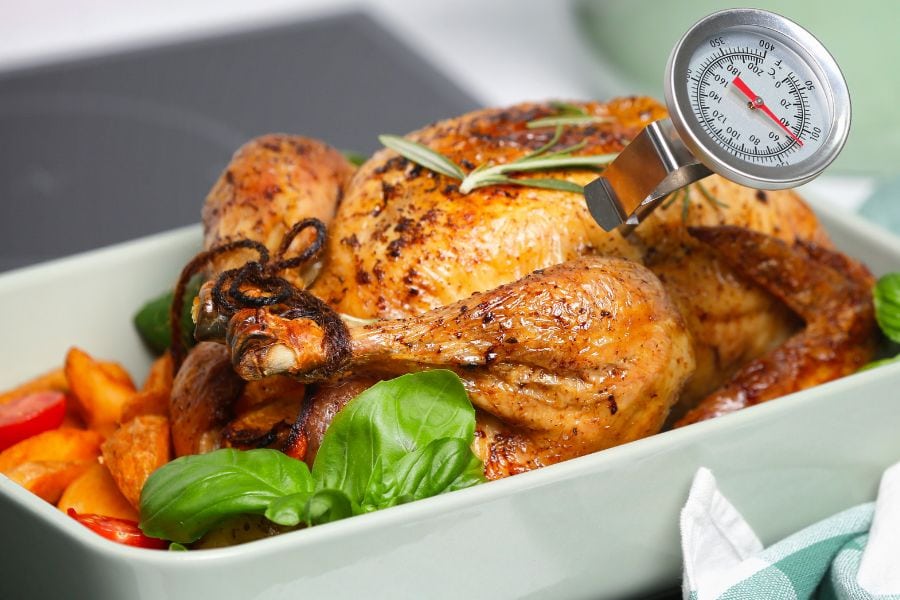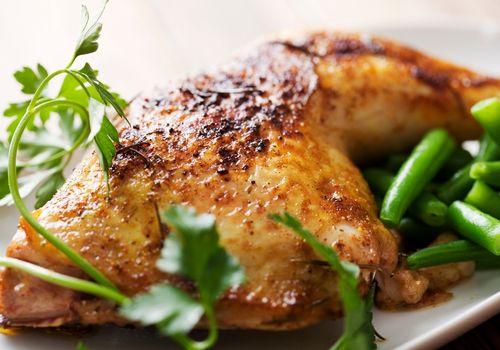My secret to accurately testing the internal temperature of cooked chicken is inserting the meat probe deep in the breast, as Weber recommends. You may also insert it in the chicken thigh. But never make the thermometer touch the bone. The general rule is to insert it in the thickest portion of flesh in whatever you’re cooking.
Excited to know more? Keep reading and I’ll show you how I’ve been ensuring my chicken never undercook or overcook during each of my recipes as a chef.

Like I said earlier, when I’m cooking a whole chicken, I like to insert the thermometer into the inner thigh area, close to the chicken’s breast meat to check the chicken’s internal temperature.
The thickest part of the chicken gives you the best shot at an accurate internal temperature. The trick here is to make sure the temperature probe is not touching bone as this may mess with the reading.
Where you put the thermometer probe generally depends on what kind of chicken cut you’re cooking – whole chicken, chicken breasts, chicken wings, etc.
Now let’s say you’re making chicken breasts. Ideally, you should put the meat thermometer in the thickest part of the meat. This is usually the center of the breast, away from the bone.
Thigh meat and chicken wing are generally more tricky to check because both areas contain bones. When inserting the temperature probe in the thigh area, avoid touching bone. So make sure it’s the meatiest part that gets probed.
For the wing, I recommend that you insert the temperature probe in the thickest part of the wing.
According to the USDA, the minimum internal temperature is 165 degrees. If the thermometer reads less than this, you have to keep cooking the chicken.
I know there are arguments as to if a chicken is cooked at 165 degrees or 175. Both are correct. But it depends on where you put the temperature probe in your chicken. It also depends on the doneness level you want.
Currently, the best-selling meat thermometer on the market is the Digital Meat Thermometer from ImSaferell. What I like best about this is it reads a result in seconds (maximum of 3 seconds). The display system is digital for accurate reading and it goes for less than $15.
If you want something more budget-friendly, you could get an instant-read thermometer like this for as low as $7. You can also find high-end thermometers like the ThermoPro TempSpike. This would be the best for commercial cooks who want something more reliable.
The quickest way I use to check if my thermometer is calibrated is by doing the ice bath test. How’s it done?
Get a glass of ice-cold water. Then insert the meat thermometer in it for about 30 seconds without touching the glass at all.
If it reads 32 degrees Fahrenheit, your thermometer is good to go. A variance of 0.1 degrees is acceptable. However, when it goes about double digits off, then something is wrong. You may retry the process and if you’re not getting 32 degrees, you may need to adjust or calibrate the thermometer.
Thermometers aside, there are other methods to check if your chicken is cooked.
One is by touching the meat. If it’s a whole chicken, touch just under the skin. If it’s soft and tender, then it’s done.
If you’re a pro cook or grill master who’s done a lot of chicken cooks, you can tell a chicken is done just by observing it. A properly cooked chicken is usually pale all over. So if parts of the chicken are pinkish or a bit bloody, then you still have an under-cooked chicken.
Both methods are not reliable or safe and I don’t recommend using any of them, especially if you’re a starter. Eating under-cooked poultry could expose you and your family to harmful bacteria such as campylobacter jejuni or salmonella, according to the USDA.
Poultry companies usually insert a pop-up timer in the thickest portion of whole chickens but I’ve found that they aren’t always accurate too. They sometimes pop even before the bird reaches 165 degrees. So I remove it before I cook. The pop-up timer is designed to pop up once the chicken reaches the right temperature.
Other times, it pops too late and leaves you with overcooked and dry chicken. A meat thermometer remains the most accurate way to ensure that your chicken is well-cooked to avoid foodborne illnesses
Typically, white meat doesn’t take long to get done, unlike dark meat, which takes longer. Of course, it all depends on the recipe, the chicken part and the source of heat. Cooking time for whole chicken takes around 1 hour and 40 minutes, while wings take around 25 minutes.
Breasts take between 25 to 30 minutes too but will come out nicely if you set your smoking temperature at 350 degrees Fahrenheit.
The important thing is that your chicken comes out juicy and delicious as overcooked chicken tends to be tough and dry.
There are several recipes for making chicken. You can make a spatchcocked chicken as I showed you in this recipe using a Traeger.
Because it always ends up juicy and tasty, with a crispy back, I like to have my chicken breasts smoked.
You can also try a chicken kabobs recipe. It’s delicious and great for a party.
If you can’t do a rotisserie chicken at home, you should try the famous homemade alternative, which is the beer can chicken.
Depending on the kind of chicken, I like to play around with recipes to get exciting new flavours. What recipe you choose depends on whether you’re using ground chicken, chopped chicken, or whole chicken.
If you’re roasting a whole chicken on a BBQ grill, how you place the meat matters. I recommend that you place the legs and thighs towards the heat and the breast away from the heat source. In my experience, this is the best way to ensure that all parts of the meat get done at the same time.
It’s different when you cook your bird in an oven since the heat circulates evenly. So you don’t have to worry about one part of the meat getting done before the rest.

The important thing to remember is that the best place to put the temperature probe is the thickest part of the meat which is usually the breast. A temperature probe helps ensure that you don’t overcook or under-cook your meat. It’s never a pleasant experience to eat either of them.